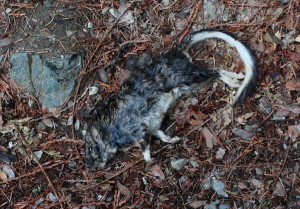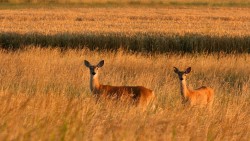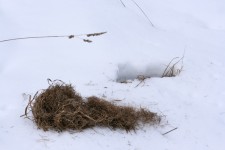After crossing one of the bridges on the Copper Creek Falls trail this spring, I came across a small dead animal that I didn’t recognize. I guessed it was a rat because of its size and long tail.
The only woodrat that lives in North Idaho is the bushy-tailed woodrat and this animal fit the description. Large round ears, long whiskers, gray fur, white-topped feet and a bushy tail with white below characterize the bushy-tailed woodrat. Unlike house rats, bushy-tailed woodrats have a well-haired, bicolor tail. The woodrats are also more closely related to deer mice than the rats inhabiting big city sewers.

The 14- to 18-inch bushy-tailed woodrat is prey for owls, bobcats, coyotes, foxes, badgers, raccoons, hawks and long-tailed weasels but the cause of death is unknown for this wet woodrat.
A more common name for the bushy-tailed woodrat is packrat. They are well-known for their urge to collect anything from sticks and stones to tinfoil and rifle shells. The bushy-tailed woodrat adds the collected items to its shelter.
The woodrat’s shelter consists of two parts: the den and nest. The den (also called a midden) is constructed from collected items such as sticks, leaves, grass, bark, feathers, small stones and human artifacts. The den protects the woodrat from predators and insulates it from cold temperatures (since they are active year-round).
Within the den are tunnels, chambers and passageways. One of the chambers has nests. The nests are small, cup-like structures made from grass and other soft fibrous materials. The other chambers are used for food storage and feeding.
In the fall, bushy-tailed woodrats begin caching food for the winter. They store dried berries, leaves, mushrooms and seeds for consumption later in the winter. As herbivores, they eat a variety of vegetation including twigs, shoots, leaves, needles, fruits and seeds.
Often dens are found in rocky areas such as cliffs, caves, talus slopes and mine tunnels. Some dens are made in hollow trees, pileated woodpecker cavities (packrats are adept tree climbers) or abandoned buildings.
Despite the distinctive odor emanating from bushy-tailed woodrats living areas they keep their nest clean. The smell comes from the separate places where they defecate and urinate.
Bushy-tailed woodrats could be considered “potty-trained” because they deposit their feces in cracks in rocks adjacent to their nests–a deliberate behavior. They also form large latrines of scats and urine along travel routes. The accumulated urine creates white calcareous deposits that are easy to see against dark rocks.
However, woodrats do urinate on top of their dens. As this urine crystallizes, it cements together collected items. Since dens can be utilized by many generations, they can become quite large. When a nest owner dies, another woodrat takes over.
Dens of bushy tailed woodrats in the Southwest can be over several thousand years old–even 40,000 years old. Archaeologists and paleontologists study the dens for insight into the past plant, animal and human communities in the area.
In areas occupied for a long time, the droppings can form deposits resembling geologic formations. The metamorphosed droppings and urine are humorously called “amberat” and “ratite” since they can contain pollen, leaves and bones similar to amber.
While the larger dens are a treasure chest for archaeologists, other animals benefit from the dens. Rabbits, mice, snakes, tree frogs, toads, lizards, shrews and other small animals find shelter in the outer nooks and crannies of the den, along with ticks fleas and insects.
Bushy-tailed woodrats are mainly nocturnal to avoid predators and to stay cool (they use their tail to curl up in) so we are more likely to find their dens than see the packrat itself, unless it had an unfortunate ending.




